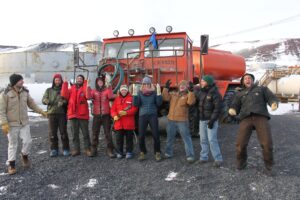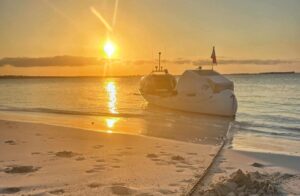Pacific Ocean
Michelle’s Pacific Row: Michelle Lee has been rowing for 190 days. She is paddling from Ensenada, Mexico to her home in Australia. She expected to reach Sydney by the end of February, but storms have made that impossible. At one point, she had only 800km to go, but winds have pushed her back so far that she is now 1,300km from Sydney.
Before this setback, she managed to avoid five hurricanes and one cyclone. This recent storm, a gift from Cyclone Gabriel, moved along the coast of Australia and created un-rowable conditions. She has now been inside her cabin for six days. Lee expects to hunker down for a further two to three days.
“I just hope my body goes right back into enjoying being on the oars for 10-12 hours a day after all this rest,” she wrote.
Richard Barnes: The Australian has been paddling across the Tasman Sea between Tasmania and New Zealand for 58 days. Barnes first attempted the crossing in 2021 but had to stop after 75 days because of Cyclone Seth.
Atlantic Ocean
Talisker Whisky Atlantic Challenge: This rowing race touts itself as “the world’s toughest row.” On Dec. 12, 43 teams with a total of 127 rowers set off. Soloists, pairs, trios, and quads are battling their way across the 4,800km between Tenerife and Antigua.

Dark Trio crossed the finish line in 35 days, 7 hours, and 3 minutes. Photo: Atlantic Campaigns/Facebook
After 31 days, 17 hours, and 9 minutes, this year’s winners crossed the finish line. OceanCats is a four-man crew made up of Joaquim Planelles, Juan Romero, Sergi Franch, and Marti Ramirez.
At one point they thought they might have to pull out of the race. On Dec. 21, their battery stopped working, which meant that so did their autopilot, navigation system, and water maker. Luckily, they were able to fix the problem.
Since then, many other crews have finished. Some have broken race speed records:
- Fastest Female Solo Crossing: Miriam Payne – 59 days, 16 hours, and 36 minutes.
- Fastest Trio Crossing: Dark Trio (Gareth Keighley, Charlie Taylor, and Aaron Kneebone) – 35 days, one hour, and 33 minutes.
- Fastest Five Person Crossing: Row Hard or Go Home (Tom Nolan, Diarmuid Ó Briain, Shane Culleton, Gearoid O’Briain, Derek McMullen) – 33 days, 12 hours, and 39 minutes
- Fastest Mixed Four: Team NEDurance (lja Kok, Marcel Ates, Ingeborg Dijkstra, and Guus Koppes) – 32 days, 23 hours, and 53 minutes.
Five crews remain on the water.
Atlantic Dash Challenge: The Atlantic Dash Challenge is the second race taking place on the Atlantic. A smaller-scale event than the TWAC, it features only two crews this year, both from the UK. Atlantic Dragons is a pair made up of Adrian Tyrrell and Daniel Bohin. Cabbies Do Atlantic Row is a trio consisting of Robert Barber, Darren Parr, and Stuart Lockhart.

Image: atlanticdash.com
Neck and neck
The race began on Jan. 3 from the Canary Islands, off the coast of West Africa, and goes to Antigua. Both crews have been neck and neck from the start. At the moment, Cabbies Do Atlantic Row are 113km ahead of their rivals.
One of the main reasons for their slim lead is that Cabbies Do Atlantic Row has a functioning auto-helm. This piece of equipment failed for the Atlantic Dragons earlier in the row. They’ve had to steer manually, which has made their route slightly less direct and slowed them down.
Jari Saario: On January 23, Jari Saario started his ambitious two-way crossing of the Atlantic. He will first row 8,000km from the Canary Islands to Miami. Following this, he will wait in the U.S. for a suitable weather window before rowing back across the Atlantic to London. If successful, he will be the first person to do a two-way crossing.
At first, he had to contend with strong winds and waves, but these have now calmed. After 12 days, he had covered 1,000km.
At one point, his water maker broke. This device converts seawater into fresh drinking water. He managed to fix it on a calm day.
Saario has also struggled with homesickness, especially on his daughter’s birthday.

Aurimas Valujavicius. Photo: KeliautojasAV/Facebook
Halfway there
Aurimas Valujavicius: The Lithuanian man is rowing from Spain to Miami. In the first month, he covered 2,000km, and after 50 days, he reached the halfway point. Vaujaviius described the experience as “lots of waves, lots of wind, lots of mood swings, and a smile on my face.”
The early wind has died down and he is making good progress, despite dealing with numerous blisters on his hands.
Rame Ocean 2023: This six-man crew is rowing from Spain to Guadeloupe. Patrick Favre (FR), Louis Pellet (FR), Dominique Pape (FR), Christophe Huguet (FR), Jerome Caudoux (FR), and Liu Yong (CN) began on Jan. 30. Over the last two weeks, they have covered 1,209km.
For the first few days of the row, there was very little wind and only small swells. Still, they struggled to sleep and were seasick. They commented that it was like trying to sleep “in a warm washing machine on a spin cycle.”
But within a week, they had adapted to life on board. Then conditions worsened. Large waves tested their newfound sea legs. Once, a wave crashed onto Huguet while he was using the satellite phone and broke it. Fortunately, they have another one. The crew has decided to take a more southerly route to avoid headwinds.

Photo: Rame Ocean/Facebook
Eleven previous crossings
Broken Pinkies: This four-man crew is rowing from Portugal to French Guyana. Ralph Tuijn (NL), Jordan Godoy (U.S.), Fionn O’Carroll (IE), and Ciaran Kavanagh (IE) set off on Jan. 14.
The very experienced Tujin has previously completed 11 ocean crossings and spent 904 days at sea before this adventure. The crew is trying to beat their own Atlantic crossing time. Initially, they were supposed to be a crew of five, but one had to drop out. Unable to find a replacement, they decided to continue as a foursome.

Simon Howes.
Simon Howes: Howes is rowing from the Canary Islands to St. Lucia. Since starting on Jan. 16, he has completed 43% of the route. If he succeeds, he will become the second person to complete that particular route.
He first attempted to row the Atlantic solo in 2021 as part of the TWAC. Just days in, he slipped on the deck and injured his elbow, forcing him to pull out. Now he is retrying on his own.
Row for Amy: Andrew Osbourne (UK) is rowing from the Canary Islands to Antigua in memory of his daughter. She died in her sleep five years ago due to an undiagnosed heart condition. He set off on Jan. 8.
After 37 days at sea, he has almost reached the halfway point. Like Jari Saario, he too is suffering from loneliness. On day 35, Osbourne detoured for five hours just to have a face-to-face conversation. He noted on his radar that Linda Emilsen, one of the TWAC sailors, was not too far away so he rowed over to her. They were just 20 meters apart. After their chat, he threw her a bag of candies and continued on his way.
Antarctic Ocean
Antonio De La Rosa: On Jan. 7, De la Rosa started rowing 1,000km across the Drake Passage to Antarctica. This was supposed to be the first phase of a three-part challenge. After paddling to the Antarctic Peninsula, he erected a small sail and traveled a further 1,500km to South Georgia via Elephant Island, as Shackleton did. He was then going to cover the final 50km across the island on foot.
He successfully completed the first two stages to South Georgia, although dangerous katabatic winds forced him to land at the south end of the island, rather than at the north end, as he’d planned. The support boat required for all Antarctic rows figured in this decision; the crew was concerned about their own safety.
Once on South Georgia, he had to cancel the trek. The authorities that administer the island refused to give him permission to undertake the solo hike and ski.

Photo: Antonio de la Rosa/Facebook
“It’s really not any extraordinary challenge,” he reasoned on social media. “It’s not a tourist route, but every year, dozens of people do it. The real challenge was getting here by paddling and sailing.”
Paused expeditions
Ellen Magellan Expedition: Ellen Falterman began a row around the world on Sept 3. She started in East Texas, then followed the Gulf Intracoastal Waterway to the Florida Panhandle. From there, she crossed the Gulf of Mexico to South Florida. The 27-year-old is aiming to be the first person to complete a global circumnavigation by rowing.
She paused to spend Christmas with her family, but since then, she has suffered a number of family bereavements. She has not said when she will resume her expedition.
Tom’s Pacific Row: Tom Robinson is rowing across the Pacific from Lima, Peru to his home country of Australia. On Dec 10, after 160 days at sea, he completed the first section of his row. This leg saw him row 9,260km to Penrhyn, an atoll in the northern Cook Islands.
He will remain on the island, which he has called “paradise under the sun,” for the next few months until the cyclone season ends in April. Then he will row the rest of the way to Australia in stages, from Penrhyn to Samoa and then to Fiji. His final stop before Australia will be New Caledonia.






